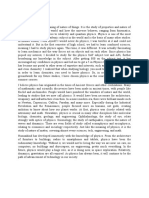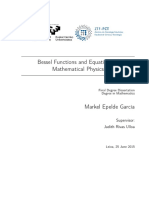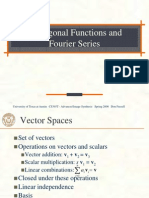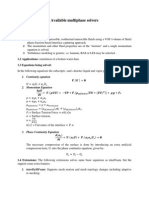Chapter 1
Physics, the Fundamental
Science
Lecture PowerPoint
© 2019 McGraw-Hill Education
In this course, we are going to get a conceptual introduction – heavy on the concepts, light
on the math – physics, the science that underlies all other sciences.
1
� Spirit of Inquiry 1
Why does the
rainbow appear
in the east?
What causes the
different colors?
Why are the
colors in the
fainter rainbow in
reverse order?
© 2019 McGraw-Hill Education Courtesy of Sally Cantrell Griffith
Physics is about asking questions and finding answers … answers that are supported by
evidence.
Consider these questions. Physics has answers!
2
� Scientific Enterprise 1
How do scientists go about explaining things?
• Read previous ideas
• Test these ideas against observations
• Invent an explanation or hypothesis
• Devise experiments to test hypothesis
• Report results of experiments
• Withstand the test of criticism and modifications
© 2019 McGraw-Hill Education
Everything in physics, from Newton to Einstein, builds on what comes before. We then
proceed by an ongoing process of observation, hypothesis, and testing. And we keep
testing … over and over and over.
3
� An acceptable
explanation (hypothesis
or theory) must agree with
what is observed.
An acceptable explanation (hypothesis or theory)
must have predictions that can be tested.
An acceptable explanation must stand up to criticism.
Communication, in both oral and written form, is an
essential part of the scientific process.
© 2019 McGraw-Hill Education
This continual cycle of observation, hypothesis, and testing is the hallmark of all science,
not just physics. Any theoretical explanation of what we observe must make predictions
that we can test. And the testing generally means some way of gathering measurable data
that will either confirm or contradict the predictions.
4
� The concept of theory, as used in
science, is often misunderstood.
A theory consists of a set of a basic
principles.
These principles are often widely accepted.
Theories are revised if new experiments
reveal discrepancies.
© 2019 McGraw-Hill Education
Sometimes you’ll hear the phrase, “It’s only a theory.” That’s not what we mean in science.
An established theory is supported by a large body of observational evidence, and it has
usually been tested many times.
This doesn’t mean it’s perfect. We can find flaws in theories and search for better answers.
A good example is Isaac Newton’s law of gravity. It worked very well for 300 years. Then
Einstein discovered a slight flaw in it, specifically what happens when things are super
massive. This led to his general theory of relativity, which works better. Newton’s theory
still works very well for small slow objects, like a spacecraft headed to Mars, well below the
speed of light. But Einstein’s theory explains a lot more that we observe on astronomical
scales.
5
� Sciences
Life Sciences Physical Sciences
• Biology • Physics
• Health-related • Chemistry
disciplines
• Geology
• Astronomy, etc.
© 2019 McGraw-Hill Education
The sciences we study are often divided into these two categories.
6
� Physics
The study of the basic nature of matter
The most fundamental science
• Explains fundamental interactions of chemistry, biology,
etc. at the atomic or molecular level
The most quantitative science
• Heavy use of mathematics
• Numerical measurements
• This course requires minimal math since mostly
discussing the conceptual ideas
NOT just a collection of facts to memorize!
© 2019 McGraw-Hill Education
Here’s a good description of physics. Physics explains things on the most fundamental
levels, like what happens inside atoms. Other sciences, such as chemistry, build on this
foundation.
7
� Subfields of Physics 1
Classical Physics
• Mechanics - forces and motion
Many early physicists worked on military
applications. Projectile motion was an important
aspect of cannon use!
© 2019 McGraw-Hill Education
As you will see in this course, physics has practical applications in almost every area of life.
8
� Subfields of Physics 6
Classical Physics
• Mechanics - forces and motion
• Thermodynamics - temperature, heat, energy
• Electricity and Magnetism
• Optics - light
Modern Physics
• Atomic physics - atoms
• Nuclear physics - nucleus of the atom
• Particle physics - subatomic particles: quarks, etc
• Condensed matter physics - solids and liquids
© 2019 McGraw-Hill Education
9
� Subfields of Physics 7
Interdisciplinary Fields
• Biophysics
• Geophysics
• Astrophysics
Physicists: fundamental understanding
Engineers: practical applications
• Often overlapping roles
© 2019 McGraw-Hill Education
Physics now shares its work with other sciences, such as biology and astronomy.
Although we pursue pure science (like physics) for its own sake, scientific knowledge
quickly leads to practical applications. This is where the work of scientists and engineers
often overlaps.
10
� Measurement and Mathematics 1
Careful measurements are needed to test
explanations
• Different theories predict different results
• Measurement reveals which theory is correct
• For example, motion of a cannonball
© 2019 McGraw-Hill Education
An important aspect of physics is making careful measurements. Any useful theory must
make predictions that we can test with measurable results.
A good example is projectile motion. Whether this is shooting a cannonball or throwing a
football, we use quantities like speed and angle and air resistance to predict a landing
point. And then we test the theory!
11
� Measurement and Mathematics 2
The language of mathematics is convenient
• Fundamental relationships can be stated precisely
• Equations can be manipulated to form different
relationships
• Altering a pancake recipe (See section 1.4 in the text) to
serve a different number of people is an example of the
use of ratios.
© 2019 McGraw-Hill Education
The mean for quantitative data makes mathematics very important for all the sciences, but
especially so for physics.
Don’t worry to much about this, though. In this course, we will keep the math to an
absolute minimum, and you will not be tested on it (just on the concepts).
12
� Why study everyday phenomena?
The same physical principles that govern
our everyday experiences also govern the
entire universe
• A bicycle wheel, an atom, and a galaxy all
operate according to laws for angular momentum.
© 2019 McGraw-Hill Education
Why study physics? Well, that answer is quite simple … physics can explain just about
everything we encounter in the physical world, often with a few simple principles applied
to many areas.
13








































































